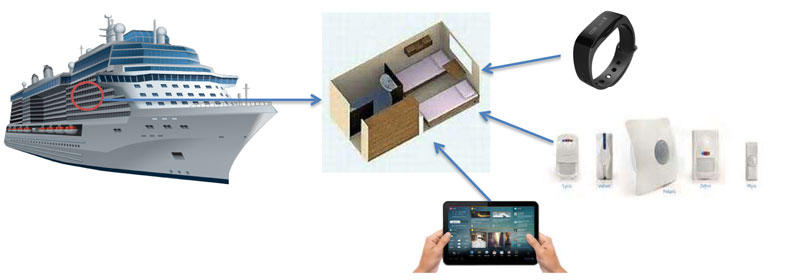by Erina Ferro (ISTI-CNR)
The National Research Council of Italy (CNR) is involved in the E-Cabin project, which aims to create a futuristic and intelligent cabin in order both to improve the well-being and satisfaction of passengers and to minimize the on-board waste by using advanced consumption control.
The E-Cabin project focusses on the cabins of cruise ships, with the aim of creating a set of advanced technology solutions to enhance the travel experience both inside the cabin and throughout the entire ship, providing the ship owner with an additional monitoring system for each cabin. A cruise ship is now a concentration of technologies, equipment, communication and security systems that is hard to find in terrestrial spaces. However, the existing set of technologies is not enough to improve the experience of individual passengers, who require both a continuous connection with the outside world and personalised tools to best enjoy the opportunities provided by the ship system. At the same time, new technological solutions can also be proposed to the shipbuilding company, thus increasing the control and safety systems.
In order to create a futuristic and intelligent cabin, E-Cabin has two primary objectives, one for the passenger and one for the shipbuilding company. In the first case, the aim is to improve a passenger’s well-being and satisfaction by making his presence on board more enjoyable thanks to a set of innovative services. In the second case, the goal is to minimise the on-board waste thanks to a precise consumption control (for example light, heating/cooling, etc.) by means of a set of solutions that include:
- To carry out a cab monitoring system in order to understand consumption, to plan the maintenance work and to dynamically manage the ship’s resources. This will be obtained via a set of sensors installed in the cab, whose battery life will be possibly extended through an energy harvesting system.
- To understand and take advantage of the correlations and the interactions between the indexes that govern feelings of comfort so as to maximise the overall comfort of passengers. This information will be collected from heterogeneous devices: sensors and actuators installed in the cabin and personal user devices (smartphones, smartwatches and/or wearable sensors) in order to detect the correct correlation between the personal feeling of well-being and the environmental data (intensity of lights, noise, temperature, humidity, etc.).
- To realise a set of applications that learn the habits of passengers, thus predicting their needs, increasing their opportunities to socialise, sharing contents through mobile social networking applications, and enriching their participation in the “ship world” by taking advantage of augmented reality information relevant to the cruise.

Figure 1: The E-Cabin.
The global e-cabin system is depicted in Figure 1. The real novelty of this approach is that all solutions will be integrated into a single development platform for the various applications, which will be primarily related to the quality of life in the cabin, but which will also interact with applications related to other activities carried out on the ship. Vertical solutions, which do not communicate each other (typical of proprietary business solutions), will not be adopted. This way, all collected data will be related, thus generating additional knowledge. Just as well-being is the result of a combination of different sensations, physical factors, and environmental factors, applications developed in E-Cabin and applied technologies must also be able to combine and share data and information in order to customise solutions.
On-board energy consumption will be monitored and automatically reduced by implementing waste reduction policies based on strict waste control; this aspect is of particular interest to the ship owner. All developed components will be miniaturised and integrated into the entire E-Cabin system. The E-Cabin prototype can be fully engineered and integrated in time with new features and applications that can be matched with evolving needs and technology.
The experimentation will take place at Fincantieri in Trieste (Italy). This project involves the ISTI-CNR, IIT-CNR, ISTEC-CNR, ITIA-CNR, IEIIT-CNR Institutes and the University of Trieste.
Please contact:
Erina Ferro, ISTI-CNR, Italy











